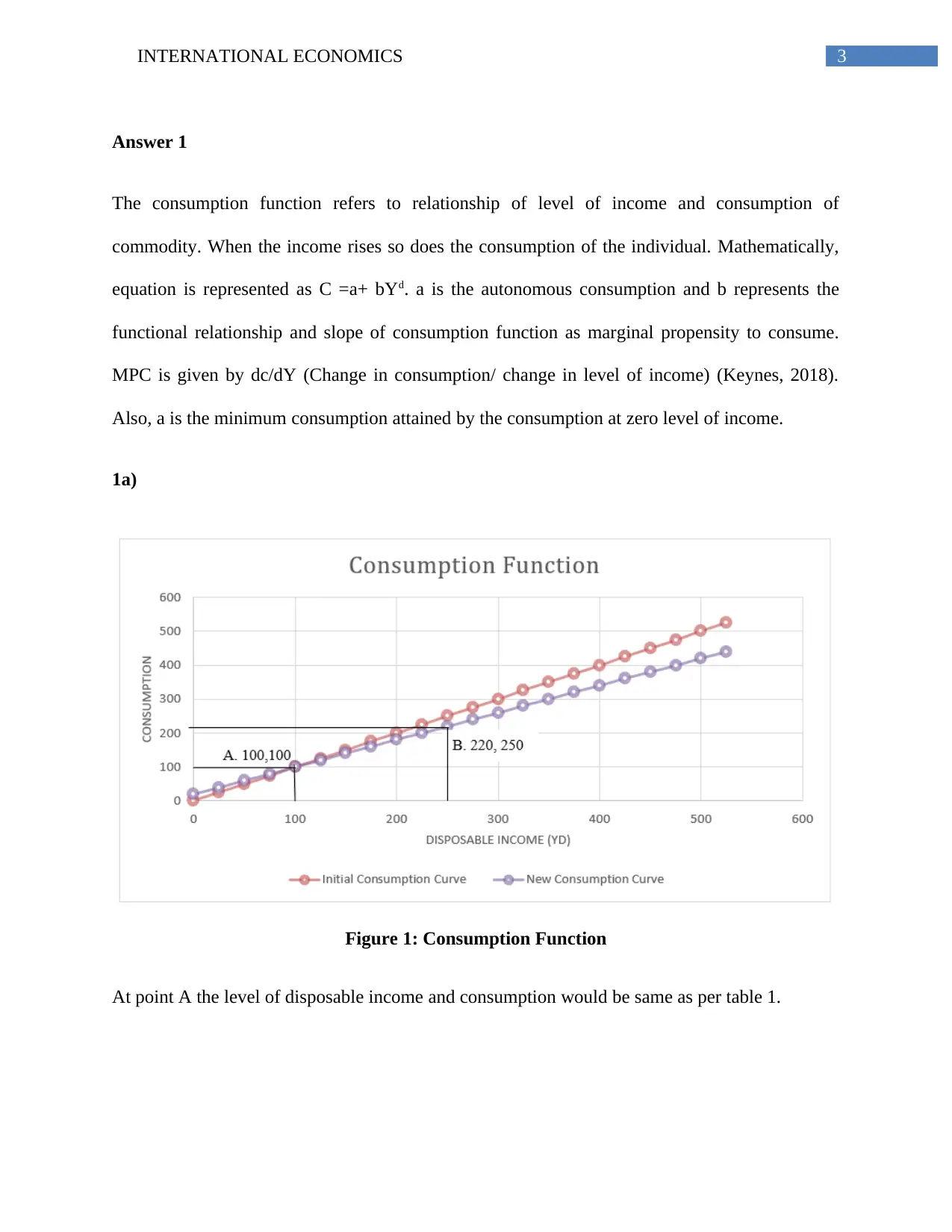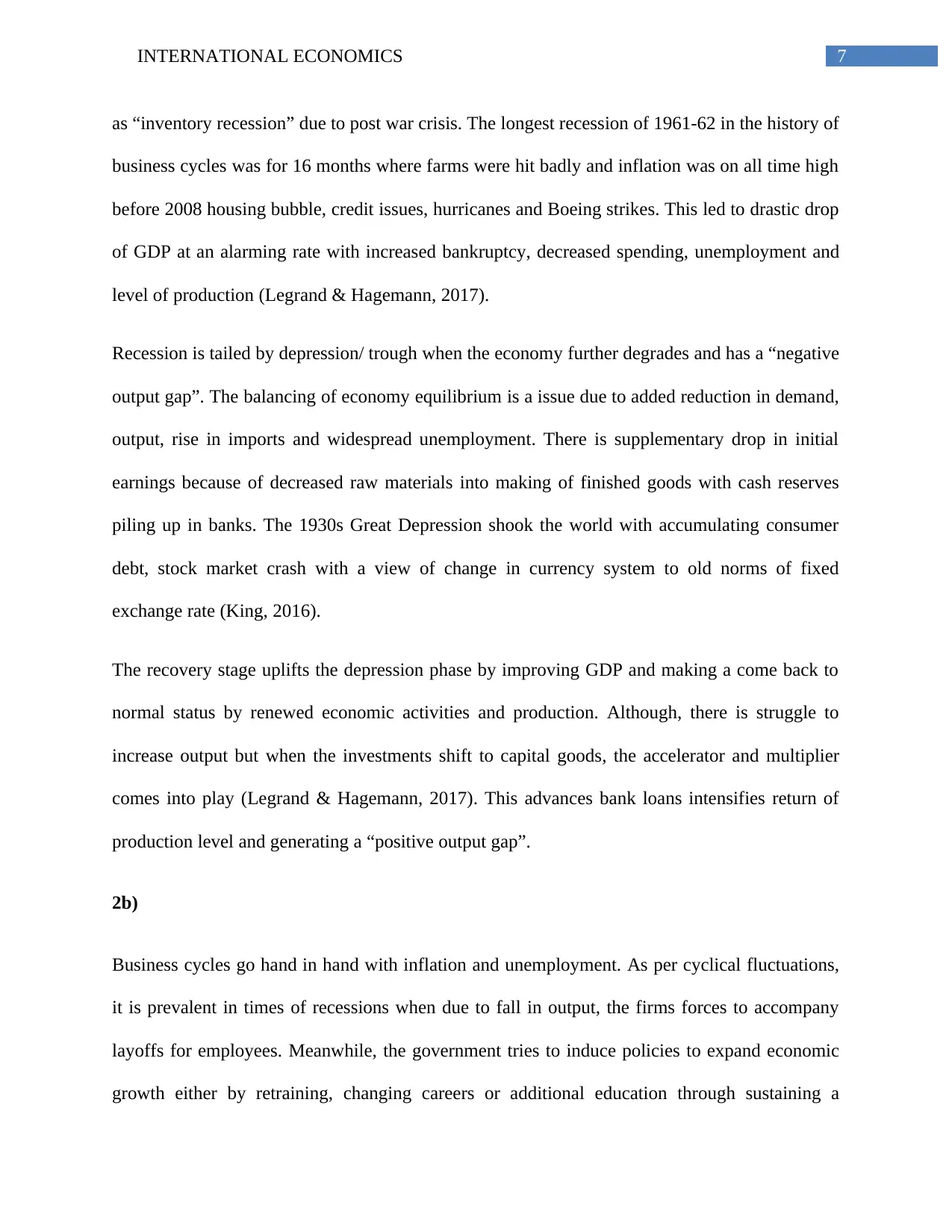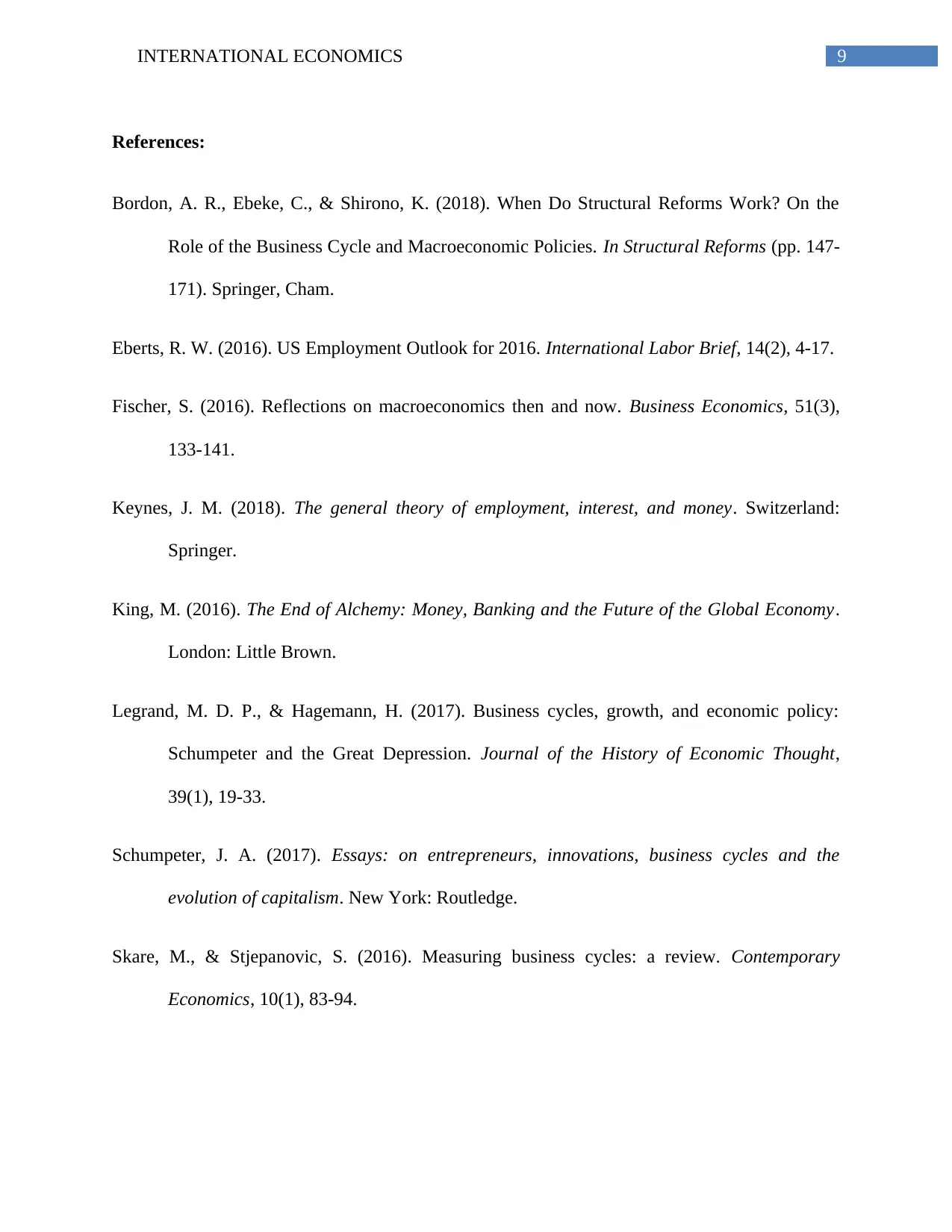Individual Assessment on Consumption Function and Business Cycles
VerifiedAdded on 2023/06/03
|9
|1616
|186
Report
AI Summary
This report delves into the intricacies of international economics, focusing on the consumption function and business cycles. It analyzes the relationship between income and consumption, highlighting autonomous consumption and marginal propensity to consume. The report further explores economic slowdowns and expansions, linking them to real GDP and the influence of human and physical resources. It discusses the four phases of business cycles—boom, recession, depression, and recovery—and their impact on inflation and unemployment, referencing Okun's law and the Phillips curve. The document provides a detailed overview of these economic concepts and their interconnectedness. Desklib is a valuable resource for students seeking similar solved assignments and study materials.

Running head: INTERNATIONAL ECONOMICS
International Economics
Individual Assessment
Name of the Student:
Student Id:
Name of the University:
International Economics
Individual Assessment
Name of the Student:
Student Id:
Name of the University:
Paraphrase This Document
Need a fresh take? Get an instant paraphrase of this document with our AI Paraphraser

2INTERNATIONAL ECONOMICS
Table of Contents
Answer 1..........................................................................................................................................3
1a)....................................................................................................................................................3
1b)....................................................................................................................................................4
Answer 2..........................................................................................................................................5
2a)....................................................................................................................................................5
2b)....................................................................................................................................................7
References:......................................................................................................................................9
Table of Contents
Answer 1..........................................................................................................................................3
1a)....................................................................................................................................................3
1b)....................................................................................................................................................4
Answer 2..........................................................................................................................................5
2a)....................................................................................................................................................5
2b)....................................................................................................................................................7
References:......................................................................................................................................9

3INTERNATIONAL ECONOMICS
Answer 1
The consumption function refers to relationship of level of income and consumption of
commodity. When the income rises so does the consumption of the individual. Mathematically,
equation is represented as C =a+ bYd. a is the autonomous consumption and b represents the
functional relationship and slope of consumption function as marginal propensity to consume.
MPC is given by dc/dY (Change in consumption/ change in level of income) (Keynes, 2018).
Also, a is the minimum consumption attained by the consumption at zero level of income.
1a)
Figure 1: Consumption Function
At point A the level of disposable income and consumption would be same as per table 1.
Answer 1
The consumption function refers to relationship of level of income and consumption of
commodity. When the income rises so does the consumption of the individual. Mathematically,
equation is represented as C =a+ bYd. a is the autonomous consumption and b represents the
functional relationship and slope of consumption function as marginal propensity to consume.
MPC is given by dc/dY (Change in consumption/ change in level of income) (Keynes, 2018).
Also, a is the minimum consumption attained by the consumption at zero level of income.
1a)
Figure 1: Consumption Function
At point A the level of disposable income and consumption would be same as per table 1.
⊘ This is a preview!⊘
Do you want full access?
Subscribe today to unlock all pages.

Trusted by 1+ million students worldwide

4INTERNATIONAL ECONOMICS
Consumption Disposable Income (Yd) Autonomous Consumption (a) New consumption Function
0 0 20 20
25 25 20 40
50 50 20 60
75 75 20 80
100 100 20 100
125 125 20 120
150 150 20 140
175 175 20 160
200 200 20 180
225 225 20 200
250 250 20 220
275 275 20 240
300 300 20 260
325 325 20 280
350 350 20 300
375 375 20 320
400 400 20 340
425 425 20 360
450 450 20 380
475 475 20 400
500 500 20 420
525 525 20 440
Table 1: Consumption Determination
The table/ figure 1 shows that when the disposable income (Yd) is 100 billion dollars, the
consumption is even 100 billion dollars, that is the point A from where the households starts
saving. The marking of A. 100, 100 position is marked with green colour in table.
C=$20+0.8*Yd where. C0 = $20 and MPC = 0.8
C =$20+0.8*Yd = $20+0.8*100 = 20 + 80 = 100 (Therefore, Yd = 100
then, C = 100)
Consumption Disposable Income (Yd) Autonomous Consumption (a) New consumption Function
0 0 20 20
25 25 20 40
50 50 20 60
75 75 20 80
100 100 20 100
125 125 20 120
150 150 20 140
175 175 20 160
200 200 20 180
225 225 20 200
250 250 20 220
275 275 20 240
300 300 20 260
325 325 20 280
350 350 20 300
375 375 20 320
400 400 20 340
425 425 20 360
450 450 20 380
475 475 20 400
500 500 20 420
525 525 20 440
Table 1: Consumption Determination
The table/ figure 1 shows that when the disposable income (Yd) is 100 billion dollars, the
consumption is even 100 billion dollars, that is the point A from where the households starts
saving. The marking of A. 100, 100 position is marked with green colour in table.
C=$20+0.8*Yd where. C0 = $20 and MPC = 0.8
C =$20+0.8*Yd = $20+0.8*100 = 20 + 80 = 100 (Therefore, Yd = 100
then, C = 100)
Paraphrase This Document
Need a fresh take? Get an instant paraphrase of this document with our AI Paraphraser

5INTERNATIONAL ECONOMICS
1b)
However, as per the new consumption equation, when income rises from point A by 150 billion
dollars $150 is given by point B
C =$20+0.8*Yd = $20+0.8*(100+150) = 20 + 0.8*250 = 20+200 = 220
(Therefore, Yd = 250 then, C = 220).
Answer 2
Economic slowdowns and expansions are a part of the economic systems. The economic experts
highlights the economic discipline for the turning points in the economy. Primarily, economic
policy emphasizes on two motives, first is economic growth and second is stabilization of
economic growth. However, economic theory not only addresses the monitoring of economic
fluctuations hampering economic growth but even the inclination of institutions to mitigate the
distress in downturns in the economy through government policies (Bordon, Ebeke & Shirono,
2018). As per the discussion, economic growth and trade cycles are closely linked because the
real GDP.
Therefore, based on the above explanations, it can be stated that economic growth (real GDP) in
long run is often influenced by human and physical resources to examine the strength of business
cycles. Also, the business cycles are not influenced by short term fluctuations or the comparative
roles of monetary and real factors.
2a)
According to Škare & Stjepanović (2016), the market economy fluctuations are based on the idea
of dependence of number of variables. Technically, it is the fluctuation that is found in general
1b)
However, as per the new consumption equation, when income rises from point A by 150 billion
dollars $150 is given by point B
C =$20+0.8*Yd = $20+0.8*(100+150) = 20 + 0.8*250 = 20+200 = 220
(Therefore, Yd = 250 then, C = 220).
Answer 2
Economic slowdowns and expansions are a part of the economic systems. The economic experts
highlights the economic discipline for the turning points in the economy. Primarily, economic
policy emphasizes on two motives, first is economic growth and second is stabilization of
economic growth. However, economic theory not only addresses the monitoring of economic
fluctuations hampering economic growth but even the inclination of institutions to mitigate the
distress in downturns in the economy through government policies (Bordon, Ebeke & Shirono,
2018). As per the discussion, economic growth and trade cycles are closely linked because the
real GDP.
Therefore, based on the above explanations, it can be stated that economic growth (real GDP) in
long run is often influenced by human and physical resources to examine the strength of business
cycles. Also, the business cycles are not influenced by short term fluctuations or the comparative
roles of monetary and real factors.
2a)
According to Škare & Stjepanović (2016), the market economy fluctuations are based on the idea
of dependence of number of variables. Technically, it is the fluctuation that is found in general

6INTERNATIONAL ECONOMICS
economic activity that is organized in business enterprises. These rhythmic patterns caused due
to fluctuations in the economy are known as business cycles. The four phases as given by
Professor Schumpeter are discussed below.
Figure 2: Business Cycles
The phase of boom or peak leads to substantial rise in manufacturing volumes, optimum use of
factor of production with a rise in output; also, with rise in overall production and income are its
peak. There is a rise in flow of inward cash such that in monetary terms the profits are quick,
self-reliant and favourable trade with increase in volume of export. The self-sustained economy
gets an increased GDP because of high speculation activities and liberal credit policy in banks
(Schumpeter, 2017).
The following phase is recession phase where there is drastic drop of total goods and
manufactured products. However, the consumers go in substantial savings with less demand
because decline in wages and price. The recession has been recorded in economy since 1948-49
economic activity that is organized in business enterprises. These rhythmic patterns caused due
to fluctuations in the economy are known as business cycles. The four phases as given by
Professor Schumpeter are discussed below.
Figure 2: Business Cycles
The phase of boom or peak leads to substantial rise in manufacturing volumes, optimum use of
factor of production with a rise in output; also, with rise in overall production and income are its
peak. There is a rise in flow of inward cash such that in monetary terms the profits are quick,
self-reliant and favourable trade with increase in volume of export. The self-sustained economy
gets an increased GDP because of high speculation activities and liberal credit policy in banks
(Schumpeter, 2017).
The following phase is recession phase where there is drastic drop of total goods and
manufactured products. However, the consumers go in substantial savings with less demand
because decline in wages and price. The recession has been recorded in economy since 1948-49
⊘ This is a preview!⊘
Do you want full access?
Subscribe today to unlock all pages.

Trusted by 1+ million students worldwide

7INTERNATIONAL ECONOMICS
as “inventory recession” due to post war crisis. The longest recession of 1961-62 in the history of
business cycles was for 16 months where farms were hit badly and inflation was on all time high
before 2008 housing bubble, credit issues, hurricanes and Boeing strikes. This led to drastic drop
of GDP at an alarming rate with increased bankruptcy, decreased spending, unemployment and
level of production (Legrand & Hagemann, 2017).
Recession is tailed by depression/ trough when the economy further degrades and has a “negative
output gap”. The balancing of economy equilibrium is a issue due to added reduction in demand,
output, rise in imports and widespread unemployment. There is supplementary drop in initial
earnings because of decreased raw materials into making of finished goods with cash reserves
piling up in banks. The 1930s Great Depression shook the world with accumulating consumer
debt, stock market crash with a view of change in currency system to old norms of fixed
exchange rate (King, 2016).
The recovery stage uplifts the depression phase by improving GDP and making a come back to
normal status by renewed economic activities and production. Although, there is struggle to
increase output but when the investments shift to capital goods, the accelerator and multiplier
comes into play (Legrand & Hagemann, 2017). This advances bank loans intensifies return of
production level and generating a “positive output gap”.
2b)
Business cycles go hand in hand with inflation and unemployment. As per cyclical fluctuations,
it is prevalent in times of recessions when due to fall in output, the firms forces to accompany
layoffs for employees. Meanwhile, the government tries to induce policies to expand economic
growth either by retraining, changing careers or additional education through sustaining a
as “inventory recession” due to post war crisis. The longest recession of 1961-62 in the history of
business cycles was for 16 months where farms were hit badly and inflation was on all time high
before 2008 housing bubble, credit issues, hurricanes and Boeing strikes. This led to drastic drop
of GDP at an alarming rate with increased bankruptcy, decreased spending, unemployment and
level of production (Legrand & Hagemann, 2017).
Recession is tailed by depression/ trough when the economy further degrades and has a “negative
output gap”. The balancing of economy equilibrium is a issue due to added reduction in demand,
output, rise in imports and widespread unemployment. There is supplementary drop in initial
earnings because of decreased raw materials into making of finished goods with cash reserves
piling up in banks. The 1930s Great Depression shook the world with accumulating consumer
debt, stock market crash with a view of change in currency system to old norms of fixed
exchange rate (King, 2016).
The recovery stage uplifts the depression phase by improving GDP and making a come back to
normal status by renewed economic activities and production. Although, there is struggle to
increase output but when the investments shift to capital goods, the accelerator and multiplier
comes into play (Legrand & Hagemann, 2017). This advances bank loans intensifies return of
production level and generating a “positive output gap”.
2b)
Business cycles go hand in hand with inflation and unemployment. As per cyclical fluctuations,
it is prevalent in times of recessions when due to fall in output, the firms forces to accompany
layoffs for employees. Meanwhile, the government tries to induce policies to expand economic
growth either by retraining, changing careers or additional education through sustaining a
Paraphrase This Document
Need a fresh take? Get an instant paraphrase of this document with our AI Paraphraser

8INTERNATIONAL ECONOMICS
recovery phase after trough/ depression which further paves the path to increase in inflation in
phases of expansion or recovery (Eberts, 2016).
Figure 3: Understanding of Philip’s Curve
Herewith, after the relationship of output, unemployment and inflation with business cycles;
there are two laws – Okun’s law (output and unemployment) and Philip’s Curve (unemployment
and inflation) that support the theory of cyclical fluctuations in the economy.
The decrease in unemployment and output face in recession has an effect of fall in GDP but once
the output starts falling, the inflation that is infrequently low starts rising in while entering in
recovery phase with further increase in real GDP. The Philips’ curve is the trade-off well defined
with lower unemployment with a relative increase in inflation (Fischer, 2016). Yet, Phelps and
Friedman are of different opinion as the relationship has no future bearing and its reaction to
economic policies.
recovery phase after trough/ depression which further paves the path to increase in inflation in
phases of expansion or recovery (Eberts, 2016).
Figure 3: Understanding of Philip’s Curve
Herewith, after the relationship of output, unemployment and inflation with business cycles;
there are two laws – Okun’s law (output and unemployment) and Philip’s Curve (unemployment
and inflation) that support the theory of cyclical fluctuations in the economy.
The decrease in unemployment and output face in recession has an effect of fall in GDP but once
the output starts falling, the inflation that is infrequently low starts rising in while entering in
recovery phase with further increase in real GDP. The Philips’ curve is the trade-off well defined
with lower unemployment with a relative increase in inflation (Fischer, 2016). Yet, Phelps and
Friedman are of different opinion as the relationship has no future bearing and its reaction to
economic policies.

9INTERNATIONAL ECONOMICS
References:
Bordon, A. R., Ebeke, C., & Shirono, K. (2018). When Do Structural Reforms Work? On the
Role of the Business Cycle and Macroeconomic Policies. In Structural Reforms (pp. 147-
171). Springer, Cham.
Eberts, R. W. (2016). US Employment Outlook for 2016. International Labor Brief, 14(2), 4-17.
Fischer, S. (2016). Reflections on macroeconomics then and now. Business Economics, 51(3),
133-141.
Keynes, J. M. (2018). The general theory of employment, interest, and money. Switzerland:
Springer.
King, M. (2016). The End of Alchemy: Money, Banking and the Future of the Global Economy.
London: Little Brown.
Legrand, M. D. P., & Hagemann, H. (2017). Business cycles, growth, and economic policy:
Schumpeter and the Great Depression. Journal of the History of Economic Thought,
39(1), 19-33.
Schumpeter, J. A. (2017). Essays: on entrepreneurs, innovations, business cycles and the
evolution of capitalism. New York: Routledge.
Skare, M., & Stjepanovic, S. (2016). Measuring business cycles: a review. Contemporary
Economics, 10(1), 83-94.
References:
Bordon, A. R., Ebeke, C., & Shirono, K. (2018). When Do Structural Reforms Work? On the
Role of the Business Cycle and Macroeconomic Policies. In Structural Reforms (pp. 147-
171). Springer, Cham.
Eberts, R. W. (2016). US Employment Outlook for 2016. International Labor Brief, 14(2), 4-17.
Fischer, S. (2016). Reflections on macroeconomics then and now. Business Economics, 51(3),
133-141.
Keynes, J. M. (2018). The general theory of employment, interest, and money. Switzerland:
Springer.
King, M. (2016). The End of Alchemy: Money, Banking and the Future of the Global Economy.
London: Little Brown.
Legrand, M. D. P., & Hagemann, H. (2017). Business cycles, growth, and economic policy:
Schumpeter and the Great Depression. Journal of the History of Economic Thought,
39(1), 19-33.
Schumpeter, J. A. (2017). Essays: on entrepreneurs, innovations, business cycles and the
evolution of capitalism. New York: Routledge.
Skare, M., & Stjepanovic, S. (2016). Measuring business cycles: a review. Contemporary
Economics, 10(1), 83-94.
⊘ This is a preview!⊘
Do you want full access?
Subscribe today to unlock all pages.

Trusted by 1+ million students worldwide
1 out of 9
Related Documents
Your All-in-One AI-Powered Toolkit for Academic Success.
+13062052269
info@desklib.com
Available 24*7 on WhatsApp / Email
![[object Object]](/_next/static/media/star-bottom.7253800d.svg)
Unlock your academic potential
Copyright © 2020–2025 A2Z Services. All Rights Reserved. Developed and managed by ZUCOL.



